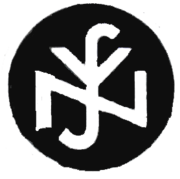
National Socialist People's Welfare
Encyclopedia

Germany
Germany , officially the Federal Republic of Germany , is a federal parliamentary republic in Europe. The country consists of 16 states while the capital and largest city is Berlin. Germany covers an area of 357,021 km2 and has a largely temperate seasonal climate...
. Its seat was in Berlin
Berlin
Berlin is the capital city of Germany and is one of the 16 states of Germany. With a population of 3.45 million people, Berlin is Germany's largest city. It is the second most populous city proper and the seventh most populous urban area in the European Union...
.
The structure of the NSV was based on the Nazi Party model, with local, county (Kreis) and group administrations.
Erich Hilgenfeldt, who worked as office head at the NSV, organized a charity drive to celebrate Hitler's Birthday on April 20, 1931. Following this move Joseph Goebbels
Joseph Goebbels
Paul Joseph Goebbels was a German politician and Reich Minister of Propaganda in Nazi Germany from 1933 to 1945. As one of Adolf Hitler's closest associates and most devout followers, he was known for his zealous oratory and anti-Semitism...
named him the leader of the NSV. The NSV became established as the single Nazi Party welfare organ in May 1933. On 21 September in the same year Hilgenfeldt was appointed as Reich Commissioner for the Nazi Winter Support Programme
Winterhilfswerk
The Winterhilfswerk was an annual drive by the Nationalsozialistische Volkswohlfahrt to help finance charitable work. Its slogan was "None shall starve nor freeze"...
(Winterhilfswerk). Under Hilgenfeldt the programme was massively expanded, so that the régime deemed it worthy to be called the "greatest social institution in the world." One method of expansion was to absorb, or in NSDAP parlance coordinate, already existing but non-Nazi charity organizations. NSV was the second largest Nazi group organization by 1939, second only to the German Labor Front.
During World War II
World War II
World War II, or the Second World War , was a global conflict lasting from 1939 to 1945, involving most of the world's nations—including all of the great powers—eventually forming two opposing military alliances: the Allies and the Axis...
, the NSV took over more and more governmental responsibilities, especially in the fields of child and youth labor.
NSV was often discriminating against Jews, and refused to provide aid to them.
After Nazi Germany's defeat in World War II
Aftermath of World War II
After World War II a new era of tensions emerged based on opposing ideologies, mutual distrust between nations, and a nuclear arms race. This emerged into an environment dominated by a international balance of power that had changed significantly from the status quo before the war...
, the American Military Government
Allied Occupation Zones in Germany
The Allied powers who defeated Nazi Germany in World War II divided the country west of the Oder-Neisse line into four occupation zones for administrative purposes during 1945–49. In the closing weeks of fighting in Europe, US forces had pushed beyond the previously agreed boundaries for the...
issued a special law outlawing the Nazi party and all of its branches. Known as "Law number five", this Denazification
Denazification
Denazification was an Allied initiative to rid German and Austrian society, culture, press, economy, judiciary, and politics of any remnants of the National Socialist ideology. It was carried out specifically by removing those involved from positions of influence and by disbanding or rendering...
decree disbanded the NSV, like all organizations linked to the Nazi Party. The social welfare organizations had to be established anew during the postwar reconstruction of both West Germany
West Germany
West Germany is the common English, but not official, name for the Federal Republic of Germany or FRG in the period between its creation in May 1949 to German reunification on 3 October 1990....
and the DDR.

